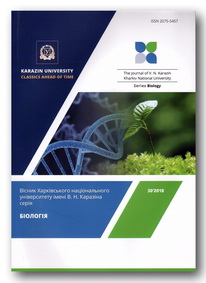New data on the fauna of mealybugs (Hemiptera; Pseudococcidae) inhabiting subtropical plants in the Lankaran-Astara Region of Azerbaijan
Abstract
Invasive insect species enter new environment mainly with their host plants and spread rapidly in new conditions due to the absence of natural entomophages that can effectively limit their numbers. Comprehensive studies of the invaders, including crop pest, are of great importance for agricultural practice. In this regard, we investigated mealybugs (Pseudococcidae) in the orchards of five subtropical species, viz. lemon (Citrus limon) mandarin (Citrus reticulate), orange (Citrus sinensis), persimmon (Diospyros kaki), and pomegranate (Punica granatum) in the Lankaran-Astara Region of Azerbaijan. The research was conducted in 2016‒2019 in various seasons. Three mealybug species were recorded from the area in question: Pseudococcus comstocki Kuwana 1902, Pseudococcus viburni Signoret 1875, Pseudococcus calceolariae (Maskell, 1879). An annotated list of species provides collecting localities, their geographical coordinates, dates of collection, and the number of individuals found. We obtained data on species distribution, biology, host plants and signs of infestation. Ps. viburni was registered in the fauna of Azerbaijan for the first time; a developement period of its larvae and imagoes is provided. The highest infestation of the vegetative organs was observed on the citrus plants: on average, 30 % of trees were damaged by Ps. comstocki, 27 % by Ps. viburni, and 21 % by Ps. calceolariae. Two mealybug species (Ps. comstocki, Ps. viburni) were found on the persimmon and only one species (Ps. comstocki) on the pomegranate. Ps. comstocki population density was the highest in the study area (3–5 larvae per 10 cm of branches, and 4–5 colonies per 100 leaves during flowering). All three species were found together on the stems and leaves of citrus crops; Ps. comstocki was observed on the fruits of mandarin and persimmon, and Ps. viburni was only on the persimmon. Based on the data obtained, the degree of harmfulness of the above species was determined: for Ps. comstocki – 3–5 larvae per 10 cm of branches, and 4–5 colonies per 100 leaves during flowering; for Ps. viburni – 2–3 larvae per 10 cm of branches, and 3–4 colonies per 100 leaves during flowering; and for Ps. calceolariae – 2–3 larvae per 10 cm of branches, and 2–3 colonies per 100 leaves during flowering.
Downloads
References
Abbasipour H., Taghavi A., Askarianzadeh A. (2007). Biological studies of obscure mealybug, Pseudococcus viburni (Signoret) (Homoptera: Psaeduococcidae) in the tea gardens of Iran. Entomological Research, 37(1): A120.
Beltrà A., Soto A., Malausa T. (2012). Molecular and morphological characterisation of Pseudococcidae surveyed on crops and ornamental plants in Spain. Bulletin of Entomological Research, 102(2), 165–172. https://doi.org/10.1017/S0007485311000514
Borkhsenius N.S. (1949). Homoptera (Coccoidea), (Pseudococcidae). (Fauna of the USSR. Vol. VII. 382 p.
Borkhsenius N.S. (1950). Worms and scale insects of the USSR (Coccidae). Мoscow-Leningrad: Publishing House of АN USSR. 249 p.
Gogiberidze A.A. (1938). Coccids of wet subtropics of the Georgian SSR. Sukhumi. P. 7–9.
Ignatova Y.А., Karpun N.N. (2011). Changes in the phytosanitary conditions of agroecosystems in wet subtropics of Russian Federation. Subtropıcal and ornamental horticulture, 44, 213–218.
Ignatova Y.А., Karpun N.N. (2013). Types of coccidus on citrus crops in the subtropics of the Krasnodar Territory. Subtropıcal and ornamental horticulture, 48, 209–220.
Imamguliyev А.G. (1966). Worms and scale insects (Homoptera, Coccidea), pests of fruit and subtropical crops of Lankaran region of Azerbaijan. Abstract of the thesis for the Degree of the Cand. Biol. Sciences. Baku. 20 p.
Jalilvand Kh., Shirazi M., Fallahzadeh M. et al. (2014). Survey of natural enemies of mealybug species (Hemiptera, Pseudococcidae) in Kermanshah Province, Western Iran to inform biological control research. Journal of the Entomological Research Society, 16(3), 1–10.
Kondo T., Muñoz J.A. (2016). Scale insects (Hemiptera: Coccoidea) associated with avocado crop, Persea americana Mill. (Lauraceae) in Valle del Cauca and neighboring departments of Colombia. Insecta Mundi, 0465, 1–24.
Mustafayeva G.A. (2003). Dangerous armored scale insect (Pseudaulacaspis pentagona Targ-Tozzetti) and its entomophages in Lankaran region. Collection of scientific articles on ecology, philosophy, culture. Baku. P. 92–95.
Mustafayeva G.A. (2013). Species composition, distribution of scale insects (Homoptera, Diaspididae) of Azerbaijan and plants damaged by them. Works of the Azerbaijan Zoological Society, 65–77.
Mustafayeva I.E. (2012). Biological features of harmful species of coccidae (Coccidae) and their natural enemies in the conditions of the Absheron peninsula. Bulletin of the Kyrgyz-Russian Slavic University, 6, 144–146.
Padilla V.J.A., Martínez E.E., Nápoles J.R. et al. (2016). Scale insects (Hemiptera: Coccomorpha) on ornamental plants in greenhouses from the central zone of the Morelos State, Mexico. Interciencia, 41(8), 552–560.
Rzayeva L.М., Ibadova S.I. (1984). Worms of Azerbaijan and biological fight against them. In: Plant Protection Issues. Tbilisi. P. 251–252.
Tanskiy V.I. (1988). Biological bases of the harmfulness of insects. Moscow: Agropromizdat. P. 132–150.
Ülgentürk S., Kaydan M., Şi̇şman Hocali̇ S. (2015). New scale insect (Hemiptera: Coccomorpha) records for the Turkish Republic of Northern Cyprus. Türkiye Entomoloji Bülteni, 5(2), 59–68. https://dx.doi.org/10.16969/teb.16125
Wunderlich L. (2009). Mealybugs in vineyards: identifying, monitoring and managing. CAPCA Adviser, 7(1), 36–41.
Yusifov E.F., Mustafayeva G.A., Guliyeva M.O. (2016). Some scale insects (Homoptera, Pseudococcidae) in Azerbaijan and their entomophages. Works of the Institute of Zoology, 127–136.
Zlotin A.Z. (1989). Technical Entomology. Kyiv: Naukova Dumka. P. 37–41.
Authors retain copyright of their work and grant the journal the right of its first publication under the terms of the Creative Commons Attribution License 4.0 International (CC BY 4.0), that allows others to share the work with an acknowledgement of the work's authorship.




